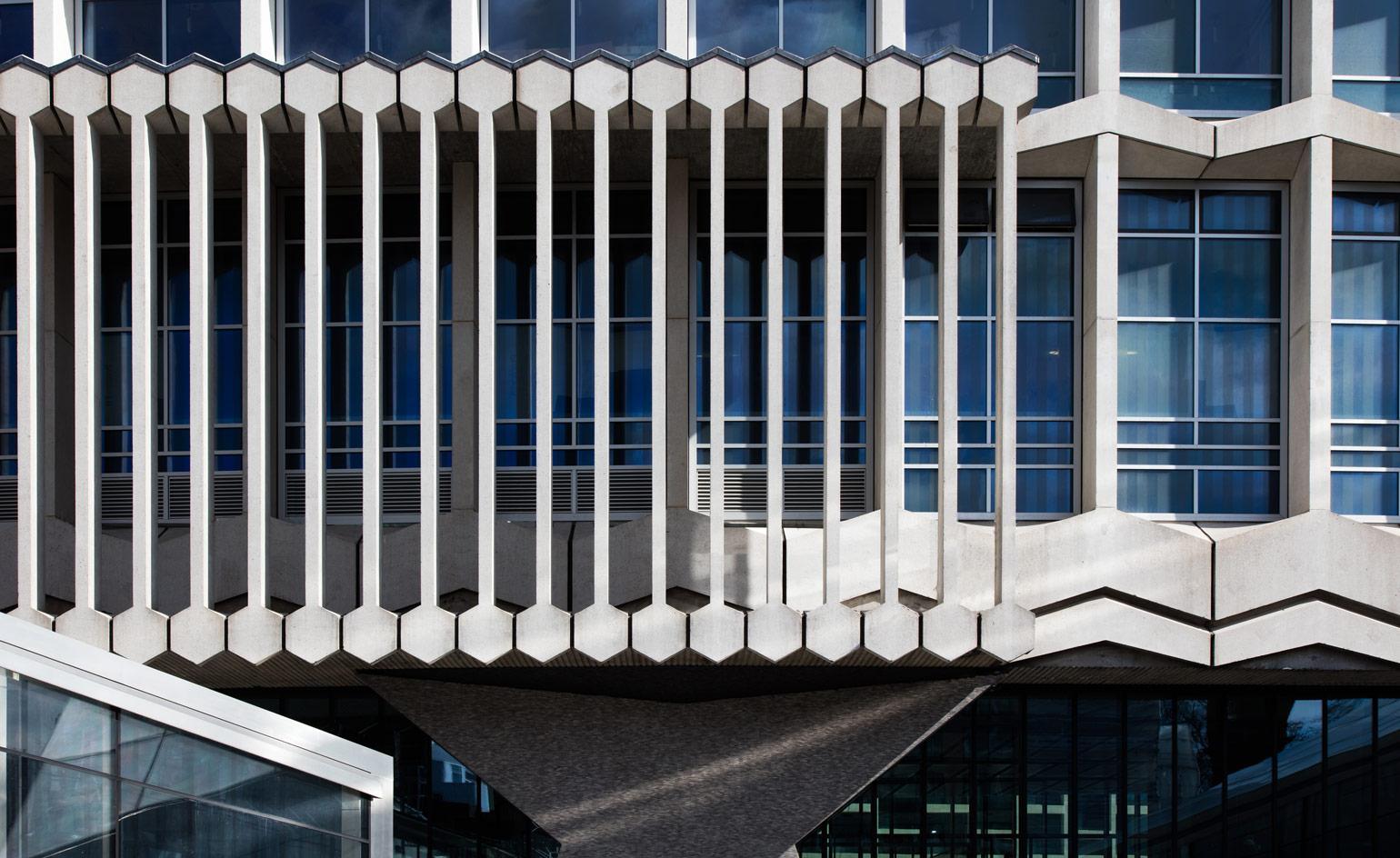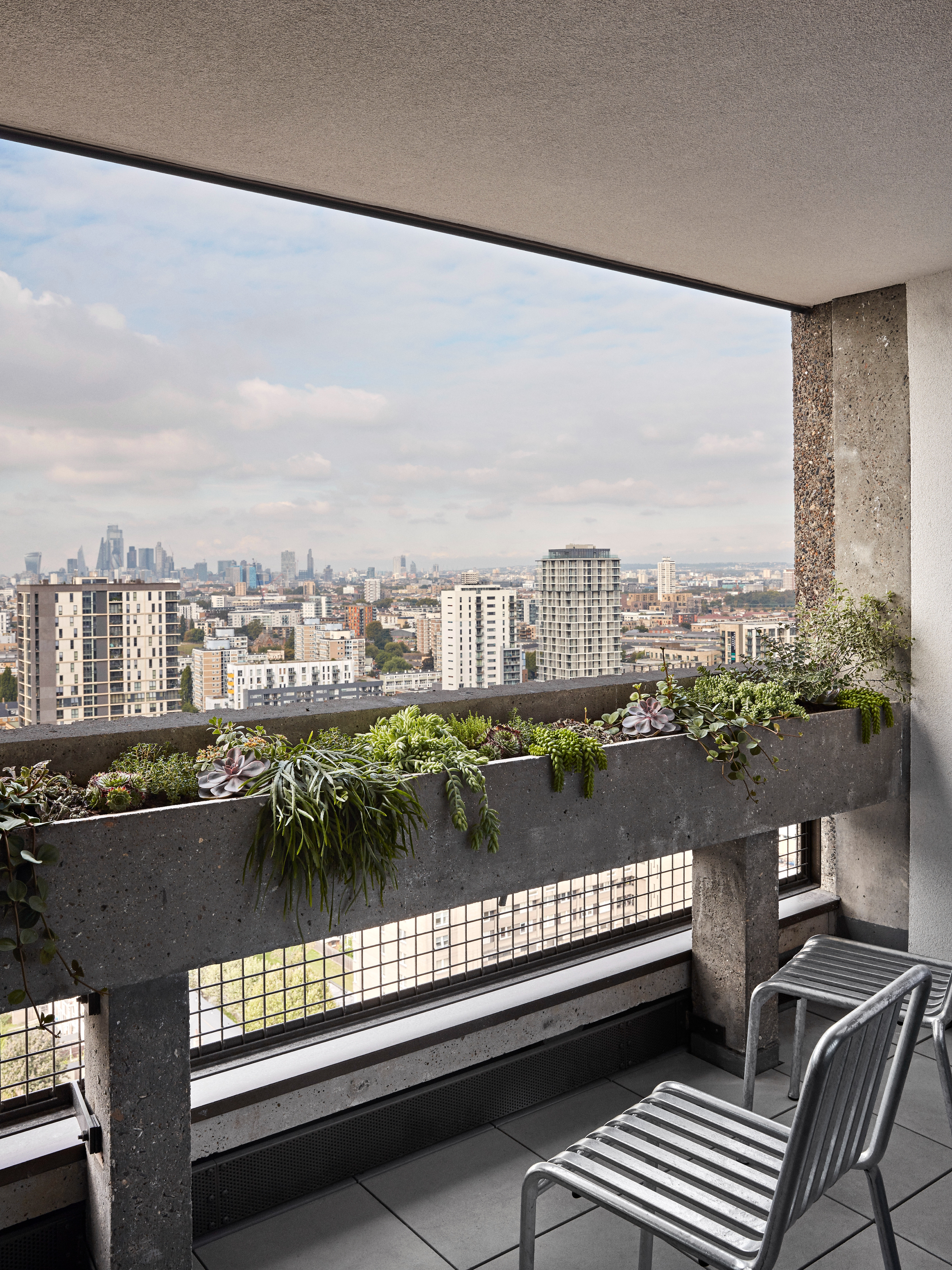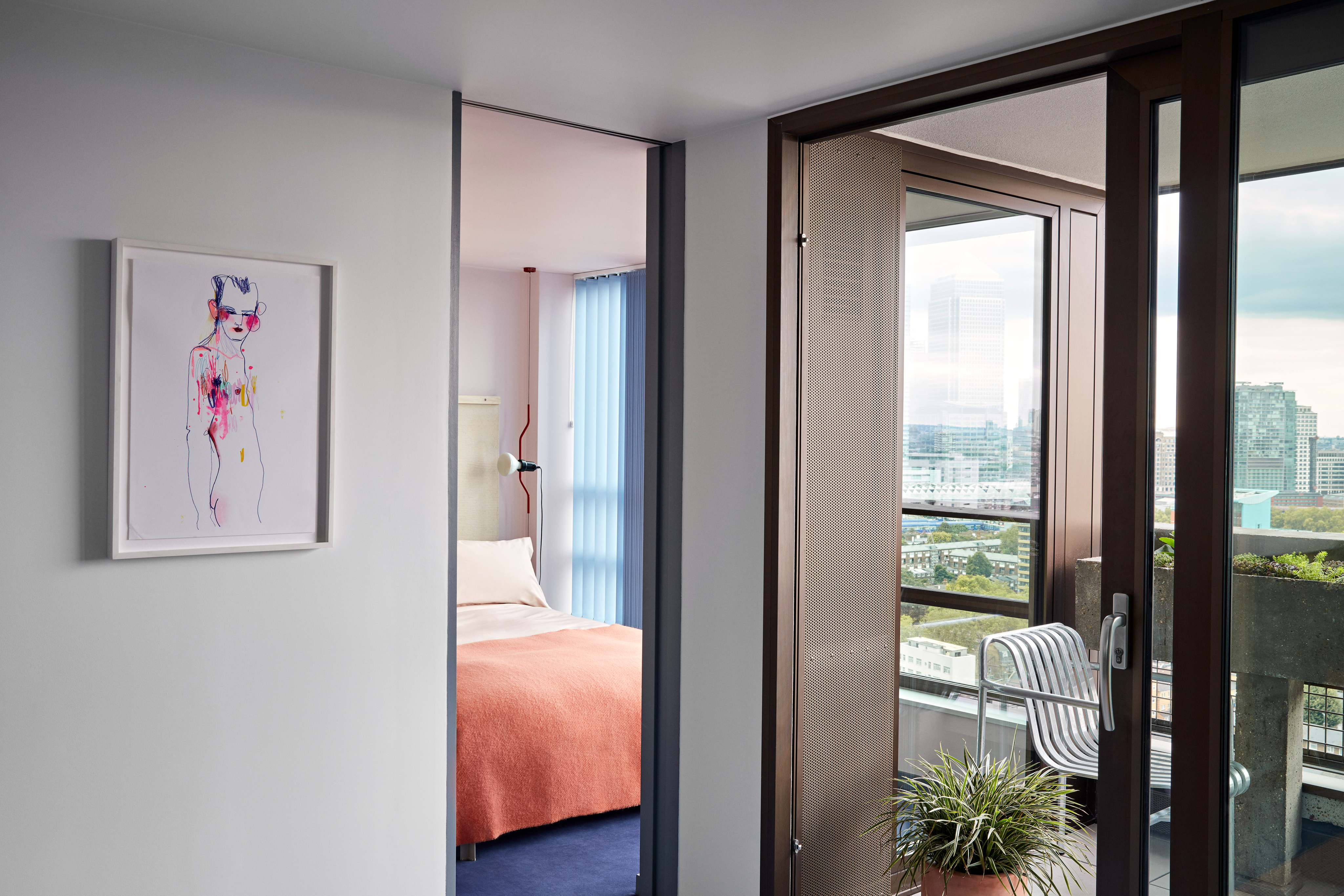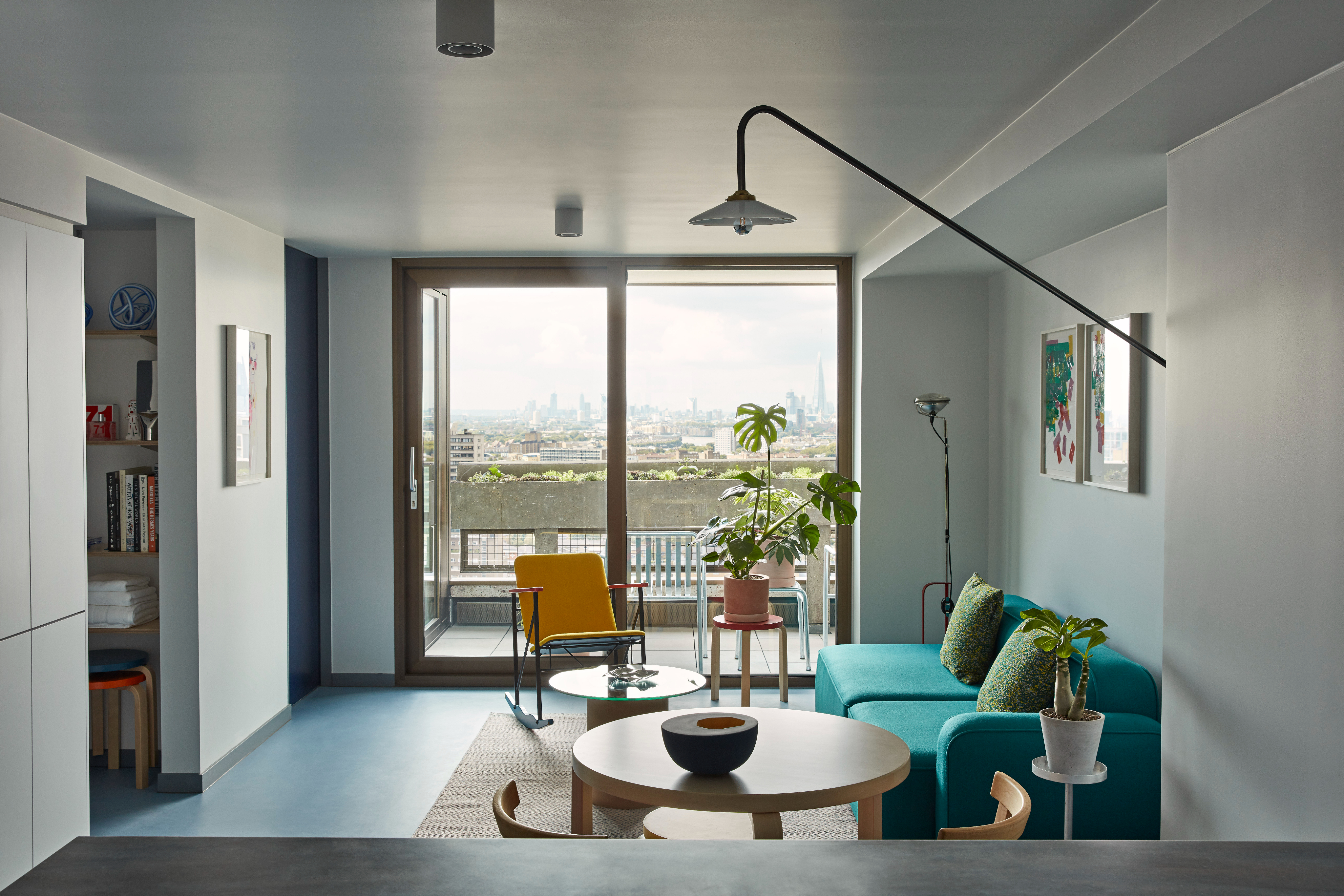London’s brutalist Balfron Tower opens two eclectically designed show apartments
Ab Rogers Design and Studio Egret West have combined restoration, creativity and collaboration to design the interiors of two show apartments in one of London’s most iconic residential towers

A couple of colourful doors to two show homes have opened in Ernö Goldfinger’s 27-storey Balfron Tower in London. Completed in 1967 for the London County Council, the iconic Grade II*-listed brutalist architecture block, has been under renovation for the last few years under the discerning eyes of englightened developer Londonewcastle, Studio Egret West (SEW) and Ab Rogers Design (ARD). The new apartment interior design has just ben revealed.
Formerly social housing owned by the borough of Tower Hamlets, the Balfron Tower, and its surrounding estate comprising two other residential buildings, developed a need in the early 2000s for complete refurbishment. In response, ownership was transferred to a housing association which alongside the total modernisation, designated the tower for private sale while maintaining social use in other parts of the estate. Located on the northern approach to the Blackwall Tunnel, the Balfron Tower neighbours the rising canal-side new builds of Aberfeldy Village, the Frederick Gibberd-designed Chrisp Street Market (soon to be razed and regenerated with some high-rise buildings to boot) and Robin Hood Gardens, a brutalist estate with a different fate.
Tasked with the building’s necessary interior redesign were SEW, the practice behind the refurbishment of Park Hill in Sheffield with Hawkins/Brown, and ARD. In total, there are 146 apartments including maisonettes from one to four bedrooms, which they split 50/50 to bring two unique design approaches to the interiors.

Balfron Tower show apartment interior
The show apartments are both accessed from floor 24, and one apartment features an entrance that opens up to a staircase down to the apartment – an original arrangement designed by Ernö Goldfinger. To reflect the current demand for a more open plan living, SEW edited the apartment plans by removing the walls between the hallway, kitchen and living rooms (made possible due to the introduction of sprinklers and kitchen extracts).
RELATED STORY

The two west-facing apartments each boast sunset views of central London, and have been dressed to evoke eclectic moods that reflect the experience of living inside a colossal brutalist hulk integral to British architectural history. The one bedroom (41.8sq m) designed by ARD with creative consultant Blue Farrier is based on the life of a kooky fictional character called Ursula Kim, while the SEW-designed two bedroom (60.8sq m) features bespoke rugs designed by 2LG Studio, their Capsule light and Stanley table, as well as a series of wallpapers inspired by the architecture of the building.
The whole building feels like a Bauhaus-style collaborative project crossing architecture, design and furniture. Londonnewcastle collaborated with the Goldfinger Factory, a furniture business/community academy/skill-sharing service based from the ground floor of the Trellick Tower, to create bespoke pieces from reclaimed materials such as the aluminium side table and felt headboard in the ARD show apartment.
As well as excitement for the future, restored elements show respect for the modernist heritage of the building. Light switches integrated within metal door frames have been reinstated and the balustrades similar to the original Goldfinger design redesigned. Six apartments yet to be revealed are also being reinstated to the original style in which Erno and Ursula Goldfinger lived in during 1968.
It was always part of Londonewcastle’s plan to preserve the spirit of Goldfinger’s modernist vision – from the uniquely coloured corridors on each floor to the communal spaces that were integral to his theories on high-rise living. While Goldfinger didn’t design a yoga room, or envision a cinema room in the tank room, these are some of the perks that 21st century residents will have in the new Balfron.

Internal window with shelving at the Ab Rogers Design show apartment

Balcony with restored concrete planters

Open plan living and kitchen at the 2LG-designed show apartment

Bedroom and balcony at the Ab Rogers Design show apartment

Bathroom at the 2LG show apartment

Bedroom at the Ab Rogers Design show apartment

Living space at the Ab Rogers Design show apartment
INFORMATION
Receive our daily digest of inspiration, escapism and design stories from around the world direct to your inbox.
Harriet Thorpe is a writer, journalist and editor covering architecture, design and culture, with particular interest in sustainability, 20th-century architecture and community. After studying History of Art at the School of Oriental and African Studies (SOAS) and Journalism at City University in London, she developed her interest in architecture working at Wallpaper* magazine and today contributes to Wallpaper*, The World of Interiors and Icon magazine, amongst other titles. She is author of The Sustainable City (2022, Hoxton Mini Press), a book about sustainable architecture in London, and the Modern Cambridge Map (2023, Blue Crow Media), a map of 20th-century architecture in Cambridge, the city where she grew up.
-
 Click to buy: how will we buy watches in 2026?
Click to buy: how will we buy watches in 2026?Time was when a watch was bought only in a shop - the trying on was all part of the 'white glove' sales experience. But can the watch industry really put off the digital world any longer?
-
 Don't miss these art exhibitions to see in January
Don't miss these art exhibitions to see in JanuaryStart the year with an inspiring dose of culture - here are the best things to see in January
-
 Unmissable fashion exhibitions to add to your calendar in 2026
Unmissable fashion exhibitions to add to your calendar in 2026From a trip back to the 1990s at Tate Britain to retrospectives on Schiaparelli, Madame Grès and Vivienne Westwood, 2026 looks set to continue the renaissance of the fashion exhibition
-
 This curved brick home by Flawk blends quiet sophistication and playful details
This curved brick home by Flawk blends quiet sophistication and playful detailsDistilling developer Flawk’s belief that architecture can be joyful, precise and human, Runda brings a curving, sculptural form to a quiet corner of north London
-
 A compact Scottish home is a 'sunny place,' nestled into its thriving orchard setting
A compact Scottish home is a 'sunny place,' nestled into its thriving orchard settingGrianan (Gaelic for 'sunny place') is a single-storey Scottish home by Cameron Webster Architects set in rural Stirlingshire
-
 Porthmadog House mines the rich seam of Wales’ industrial past at the Dwyryd estuary
Porthmadog House mines the rich seam of Wales’ industrial past at the Dwyryd estuaryStröm Architects’ Porthmadog House, a slate and Corten steel seaside retreat in north Wales, reinterprets the area’s mining and ironworking heritage
-
 Arbour House is a north London home that lies low but punches high
Arbour House is a north London home that lies low but punches highArbour House by Andrei Saltykov is a low-lying Crouch End home with a striking roof structure that sets it apart
-
 A former agricultural building is transformed into a minimal rural home by Bindloss Dawes
A former agricultural building is transformed into a minimal rural home by Bindloss DawesZero-carbon design meets adaptive re-use in the Tractor Shed, a stripped-back house in a country village by Somerset architects Bindloss Dawes
-
 RIBA House of the Year 2025 is a ‘rare mixture of sensitivity and boldness’
RIBA House of the Year 2025 is a ‘rare mixture of sensitivity and boldness’Topping the list of seven shortlisted homes, Izat Arundell’s Hebridean self-build – named Caochan na Creige – is announced as the RIBA House of the Year 2025
-
 In addition to brutalist buildings, Alison Smithson designed some of the most creative Christmas cards we've seen
In addition to brutalist buildings, Alison Smithson designed some of the most creative Christmas cards we've seenThe architect’s collection of season’s greetings is on show at the Roca London Gallery, just in time for the holidays
-
 In South Wales, a remote coastal farmhouse flaunts its modern revamp, primed for hosting
In South Wales, a remote coastal farmhouse flaunts its modern revamp, primed for hostingA farmhouse perched on the Gower Peninsula, Delfyd Farm reveals its ground-floor refresh by architecture studio Rural Office, which created a cosy home with breathtaking views